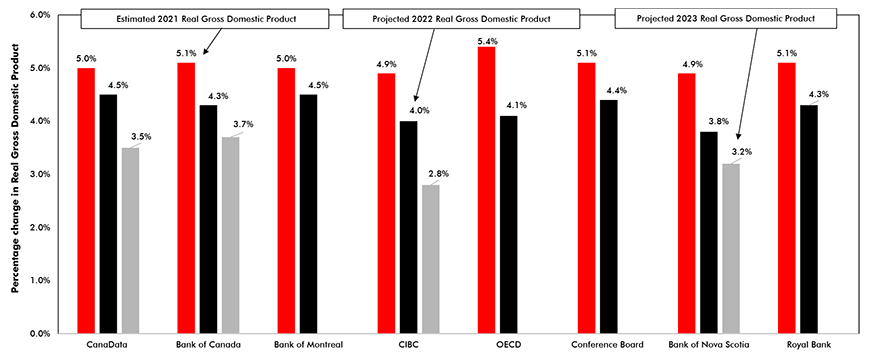Approaching the end of 2021, it is premature to say COVID-19 no longer poses a threat to global economic growth. That said, given the gradual decline in case counts due to the steady increase in the global vaccination rate (currently at 40%), the virus is posing a smaller threat to global growth than it did at the beginning of this year. While the direct negative effects of the virus are receding, its indirect impacts felt through supply chain blockages and labour shortages, compounded by energy disruptions, appear likely to weigh on global economic activity throughout next year.
Global economic indicators pointing to more stable growth
The International Monetary Fund (IMF) and the Organization for Economic Co-operation and Development (OECD) have both adopted more cautious outlooks for global growth in 2022. In their most recent forecasts, the IMF is projecting global growth to slow from +5.9% this year to +4.9% in 2022 while the OECD projects growth of +5.7% this year, followed by a gain of +4.5% next year.
The (CLI) reinforce this view. After posting strong well-above- trend increases during the first half of this year, the CLIs of most countries have recently exhibited smaller monthly gains. This indicates that global economic activity has downshifted after accelerating through the first half. The OECD has highlighted that higher consumer prices, caused by surging energy prices, are exerting a significant drag on its forward-looking economic indicators.
$1.2 trillion Infrastructure Bill adds fuel to already hot fire
The combination of measures to limit an upsurge in cases of the COVID-19 Delta variant, unprecedented supply chain issues, and an acute shortage of skilled and unskilled labour caused the U.S. economy to slow from +6.7% q/q in Q2/21 to +2.0% in Q3. While growth slowed in Q3, inflation ticked higher from +5.3% y/y to +5.4% y/y.
Looking ahead, the recent passage of a $1.2 trillion infrastructure bill materially improves the outlook for capital spending on roads and bridges in the U.S., as well as on broadband internet and on an overhaul of the electrical grid. However, with inflation moving to levels last seen in 2006, we expect the Federal Reserve to begin hiking interest rates sooner than originally intended, thereby putting a damper on consumer spending and housing demand.
Having said this, rising vaccination rates across the US will reduce the drag on growth due to COVID-19 and give a boost to the travel and hospitality industry. Supply chain issues have contributed to a growing backlog of new orders and total private employment is up by 5.3 million jobs since the beginning of 2021. With both the and the Job Openings and Labour Turnover (JOLTS) indices at record highs, the outlook for hiring remains positive.
Strong year-to-date job gains, persisting (for now) low-interest rates and a rebound in consumer confidence should cause consumer spending and residential construction to underpin growth heading into 2022. Nevertheless, we expect the impact of a gradual tightening of monetary policy aimed at reining in inflation, persisting shortages of critical materials, and ongoing hiring problems will limit growth to +3.2% to +3.7% next year following an estimated gain of +5.4% in 2021.
Strong profits and investor confidence point to good CAPEX in Canada
After a COVID-19 driven retreat in the second quarter, the Canadian economy has picked up speed due to a rebound in consumer spending on services, stronger growth of non-residential construction, and increased foreign demand for oil, natural gas, and lumber.
Going forward, growth should be driven by several key components of demand. First, the sustained rise in employment over the past four months and the recent gain in the point to solid growth of consumer spending.
Second, the outlook for non-residential business investment is brighter now than it has been for several years. This is due to record-low interest rates, strong gains in investor confidence (as reflected by rising stock prices), the acceleration in corporate profits in the first half of the year, and the positive net investment plans reported by the Bank of Canada (BoC) in its third-quarter Business Outlook Survey.
Third, sustained growth in the U.S. economy, should continue to drive merchandise exports.
While the increased penetration of vaccines has reduced the risk of another growth-stopping COVID-19 wave, rising inflation due to supply chain blockages and rising energy prices increase the risk that the BoC will tighten monetary policy to cool growth. For now, the BoC is waiting to see what happens on the inflation front before tapping the interest rate brakes. However, increased upward pressure on energy prices, lingering supply chain disruptions, and persisting shortages of skilled labour appear likely to force the BoC to hike rates mid-way through 2022.
Given the unanticipated impact of the third wave of COVID-19 on second-quarter spending, we now estimate Canada’s growth this year at +5.0%. With slower growth in the U.S. and higher domestic interest rates, we expect Canada will expand by +4.2% to +4.7% in 2022 and by +3.2% to +3.6% in 2023.
John Clinkard has over 35 years’ experience as an economist in international, national and regional research and analysis with leading financial institutions and media outlets in Canada.
Comparison of Forecasts of Canadian Real Gross Domestic Product for 2021, 2022 and 2023

Data Sources: CanaData, Bank of Canada, Bank of Montreal, CIBC, OECD, Conference Board of Canada, Bank of Nova Scotia, Royal Bank.
Chart: ����ӰԺ — CanaData.
Please click on the following link to download the PDF version of this article:


Recent Comments
comments for this post are closed